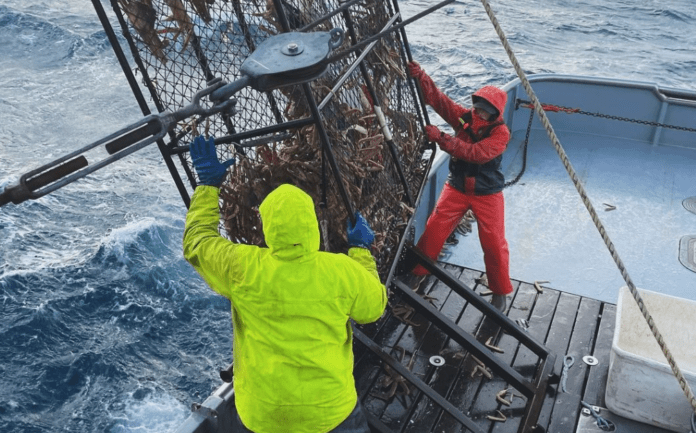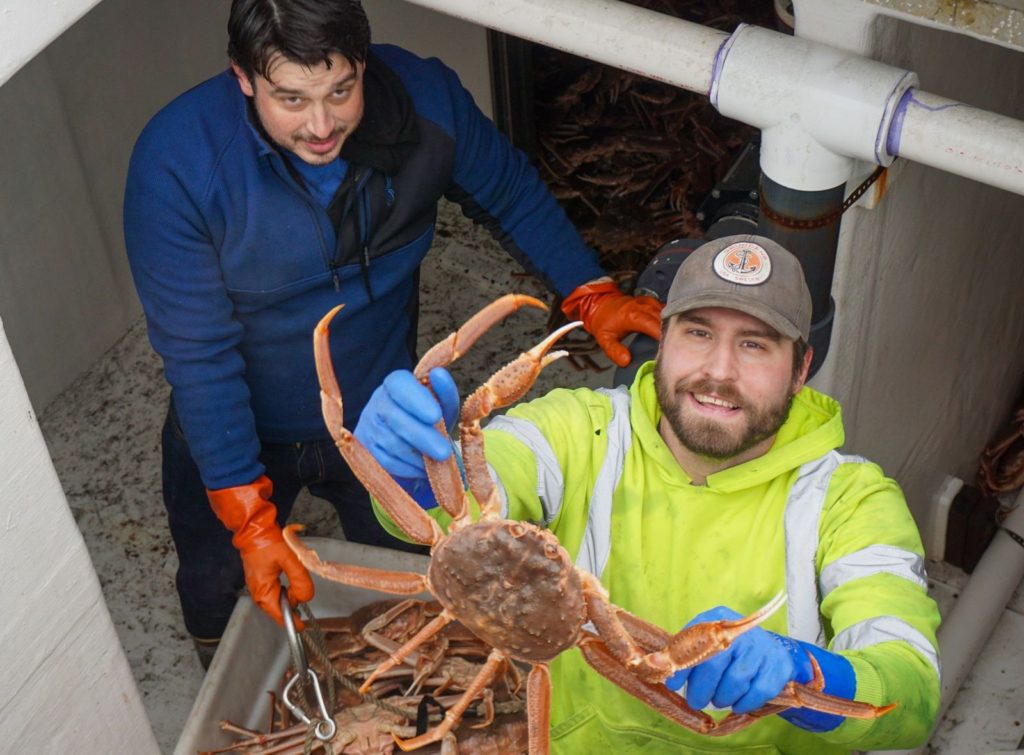
As crab fisheries around the state become increasingly unstable over the last two years, fishermen have found reliable opportunities in Kodiak.
Several Cordova vessels and captains journeyed to Kodiak this past month to participate in the 2024 Kodiak tanner crab fishery, a state fishery managed by the Alaska Department of Fish and Game (ADF&G). The fisheye opened at noon on Jan. 15 and closed on Jan. 21. This year Guideline Harvest Levels (GHL) allowed for 3,480,000 pounds of crab to be harvested by the fleet, down from the 7,300,000 pounds GHL in 2023.
Last year the fleet staged a strike over the low grounds price of crab resulting in more than a week’s delay to the season. Although the price rose only marginally this season, the fleet went fishing on the regularly scheduled opener. Trident, whose Kodiak plant is slated to close later this year, offered $3.70 per pound grounds price. Ocean Beauty Icicle and Pacific also offered the same.
To gain flexibility within such tight ex-vessel margins, many fishermen are seeking to direct market their catch in hopes of higher profits. Such plans rely closely on logistics and the willingness of processing facilities to sell crab back to fishermen or custom process parts of their catch. The F/V Lucid Dream was able to make a weather window departing Kodiak early in the week of Jan. 22 in order to return in time with live crab in their hold to sell on the docks. The crew sold roughly 790 individual crabs to Cordovans over a two-day period. Other vessels made plans ahead of the season to direct market their catch as frozen products online.
Michael Hand, who owns and operates the F/V Seaview, decided to sell part of his tanner harvest through the online direct market company — Drifters Fish — he runs with wife Nelly Hand.
“Direct marketing is a lot of work but it helps smooth out the price fluctuations year to year,” he said.
According to fishermen, prior to the season UniSea announced a price of $4.05 if delivered to Dutch Harbor. In order to facilitate this, many fishermen took steps to hire private tender vessels in Kodiak to bring crab to Dutch Harbor. Hand says the interest of processors in western Alaskan looking to buy Kodiak crab could be a sign of increasing demand.
“Because there’s less crab overall in the state there was definitely some competition for it,” he said.

Kodiak has remained a small beacon of stable hope for fishermen as crab populations throughout the state suffer.
In the fall of 2023, marine biologists at NOAA Fisheries identified a marine heatwave event as being the cause of mass starvation for snow crabs in the Bering Sea. These findings came a year after the population crash that caused ADF&G to close the Bering Sea snow crab fishery and the Bristol Bay red crab fishery for the first time in 50 years. The trend may be a foreshadowing to the fate of all Alaskan crab populations as ocean conditions continue to warm.
In 2019 a commissioner’s permit opened tanner crab in Prince William Sound for the first time in three decades. The fishery continued until 2022 at low harvest levels of below 100,000 pounds. Several boats that took advantage of the exclusive Prince William Sound fishery in those years traveled to fish in Kodiak this year, hoping to use the skills they’d learned in more profitable crabbing grounds.
“It’s really unfortunate that there’s not more things in the sound for our boats to do, so I think it’s sent people around the state looking for somewhere to go,” Hand said.
The run from Cordova to Kodiak requires vessels to leave the protected waters of Prince William Sound and cross portions of the open Gulf of Alaska. The weather in Kodiak this year began with fair seas and turned sour several days into the fishery, resulting in challenging conditions for all boats — especially those who have less experience in their island’s moody waters.
Hand says that the weather affected fishing efforts.
“We were not able to haul our gear as often and spent a whole day on anchor during 30-footseas,” he said.
In the midst of these difficulties, Hand says that the camaraderie of fellow Cordovan fishermen on the radio was a welcome blam to the new experience.
“It was awesome having multiple other young fishermen over here with varying degrees of experience,” he said. “It gave me much more confidence to come over here and go to work. And we need access to more year-round fisheries in order to be able to survive the market conditions right now.”














